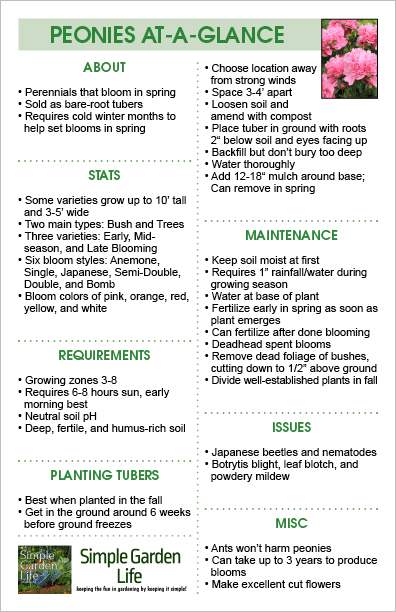Peonies are a great addition to any property. Peony’s attractive and fragrant flowers have been cherished and admired for generations. In fact, once they are established, they can grow and bloom for almost 100 years when you know how to grow peonies correctly!
Once peony trees and bushes start blooming, they will produce blooms for 4-6 weeks, and each bloom can last for 10-12 days.
Peony bushes are hardy in zones 3-8. (Find your own Growing Zone Here.) In fact, these bushes actually need the colder Winter months in order to help them set blooms for the following Spring. If you live in a location that has warmer, milder Winters, then you might have issues getting peonies to bloom consistently.
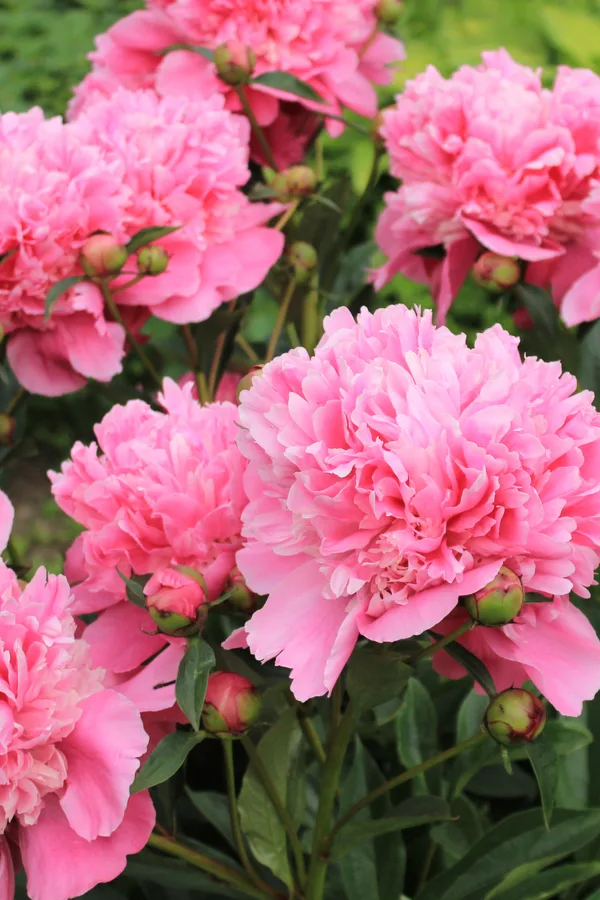
Varieties of Peonies – How To Grow Peonies
There are two main types of peonies: Bushes or Trees.
The trees are a larger, woody perennial that continues to grow on the old season’s growth. The trees defoliate in the fall but the woody stems stay behind. When the warmer Spring weather returns, they tend to set blooms earlier than peony bushes. Peony trees can grow up to 10 feet tall, and the blooms can be over 12 inches across.
Peony bushes, on the other hand, are a bit more popular and what you typically see growing in most yards. They are a herbaceous plant that dies back all the way to the ground each Fall. The blooms grow to be about 3-4 inches across.
You need to deadhead peony bushes but not peony trees. We’ll talk more about this later on!.
Peony blooms come in three main varieties: Early, Midseason, and Late Blooming. This refers to when the plants begin to bloom. Having multiple varieties can allow you to have blooming peonies from early Spring all the way through late Summer.
In addition to the three varieties, there are six main bloom types: Anemone, Single, Japanese, Semi-Double, Double, and Bomb. In addition to the six types, there are also a wide range of fragrances as well! Colors vary from pink, orange, red, yellow, and white.
So there is definitely a peony bush or tree for everyone’s taste and preference!
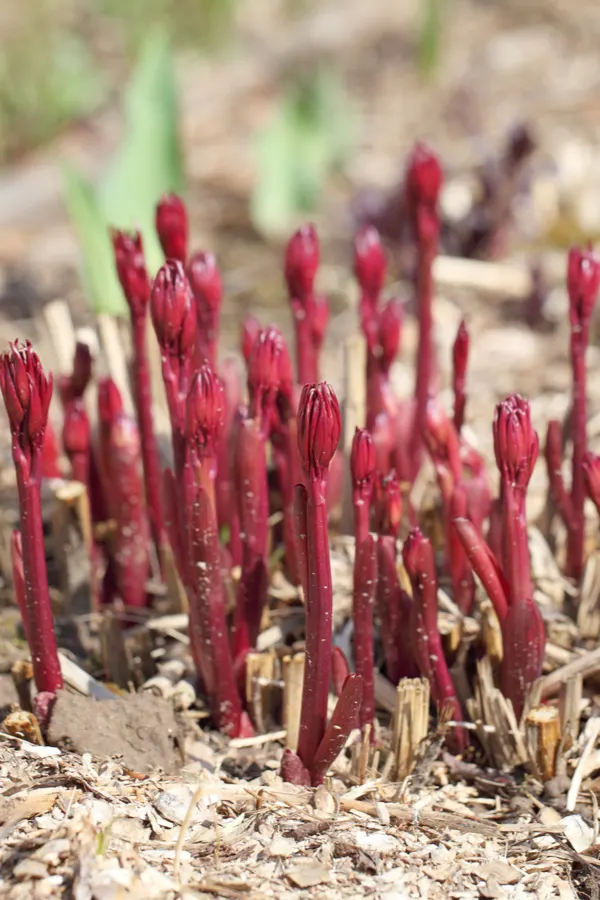
How To Plant, Grow, And Maintain Peonies
Soil Requirements for Peonies
Where you plant peonies is very important to ensure that they become established and continue to thrive year after year.
Peonies prefer soil that is deep, fertile, and humus-rich. They prefer moist soil that has a neutral pH. You might need to amend the soil by adding a rich compost mixture to your soil when planting.
The temperature of the soil when planting isn’t really as important as the timing of when you plant. Peonies grow best when they are planted in the Fall. This allows the bushes and trees to become established before needing to go dormant for the cooler winter months. Plan to have the transplants in the ground 6 weeks before the ground freezes.
You may plant peonies in the Spring, but the stress of growing can delay blooming by a full year compared to Fall-planted peonies.
Planting Peonies – How To Grow Peonies
Peonies are sold as bare-root tubers with 3-5 eyes (or buds) attached. These tubers come from a peony that is already 3-4 years old. You can also get peony transplants from established ones that have been divided.
Select a location that receives at least 6-8 hours of early morning sunlight for best growth. They should be planted in a location that has some shelter from strong winds since they produce very heavy blooms. There are commercial supports that are specifically made for peony bushes to help ensure they have adequate support you can use.
Location
Choose a location that is away from other trees and shrubs in order to prevent root entanglements and competition for nutrients.
You need to keep 3-4 feet between transplants when planting because they require adequate air circulation. In addition, established peony bushes can grow easily to be three to five feet in diameter.
Loosen up the soil around the planting area and amend with compost. This will help allow the roots to expand and become established. A post-hole digger works perfectly to help you dig deep holes quickly, and it’s perfect for transplants. Check out the podcast, 8 Simple Garden Tools & Gadgets Every Gardener Should Own, for more gardening tools and gadgets to make your life easier.
It is very important that you don’t plant peonies too deep into the ground. Place the tuber into the hole with the roots just two inches below the soil and with the eyes facing up. Back fill the soil in, making sure to keep the roots from being buried too deep. Water thoroughly at the time of planting.
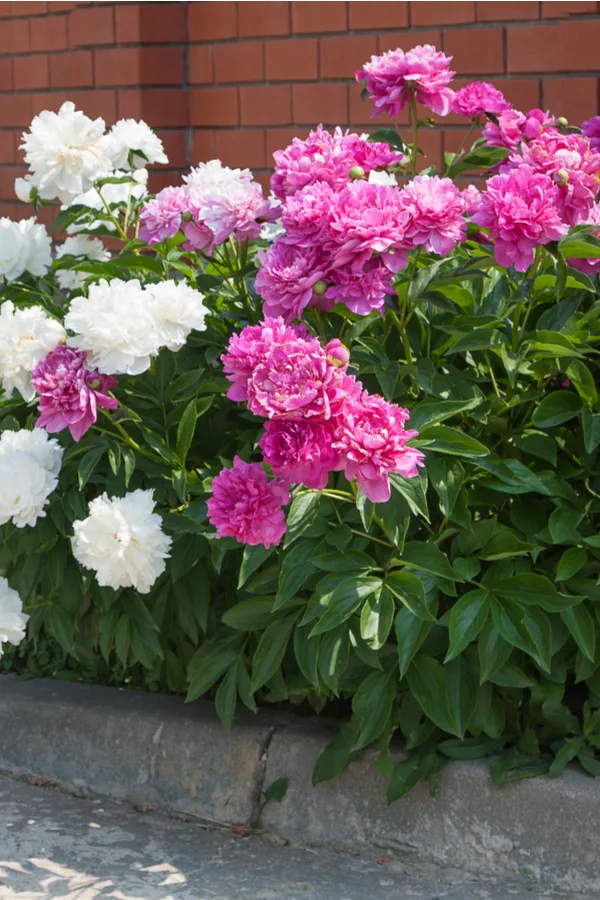
Long-Term Care – How To Grow and Maintain Peonies
Mulching
After planting, it’s best to apply a few inches of mulch 12-18 inches around the base of the plant. You will begin to see new growth when the weather warms up the following Spring. Mulch can be removed in the Spring if preferred.
Watering
Make sure to water deeply when you plant the tubers and keep the ground fairly moist to begin with. Peonies require about an inch of rainfall or watering throughout the growing season. As with most plants, it’s best to water peonies at the base of the plant and early in the morning or late at night.
Fertilizing
Fertilizing in the early Spring gives peonies a nice little boost for their upcoming blooming cycle. You should try to apply it as soon as the plant starts to emerge or even before the foliage begins to show.
After peonies are done flowering, another boost of fertilizer can be given. This will help to allow the plant to recover and sets them up for good nutrients for next year’s bloom.
Bone meal is an excellent fertilizer for peonies because it helps to re-energize the roots of the plant. Adding in compost as well will help boost the soil’s nutrients that the peony might’ve depleted during the blooming cycle.
If you are using granular fertilizers, choose one that has a lower nitrogen content for the best results. A fertilizer of 5 (nitrogen) – 10 (potassium) – 10 (phosphorous) is a great choice for maximum benefit for peonies.
Pests & Issues
While peonies are hardy and deer-resistant, they do have some pests and issues to deal with. Japanese beetles and nematodes both enjoy feasting on the foliage and blooms of peonies.
Peonies can also become susceptible to botrytis blight and leaf blotch. These fungal diseases cause damage to the entire plant and might require the removal of the plant altogether. Do not put the infected plant in your compost bin. Choose a new location for your next peony plant.
Powdery mildew is also an issue during the warmer summer months. Keeping enough space between plants when planting will help to avoid powdery mildew, as well as watering at the base of the plant.
As mentioned earlier, the blooms of peony bushes can become really heavy, so wind damage is an issue as well. Supports or stakes can help prevent wind damage.
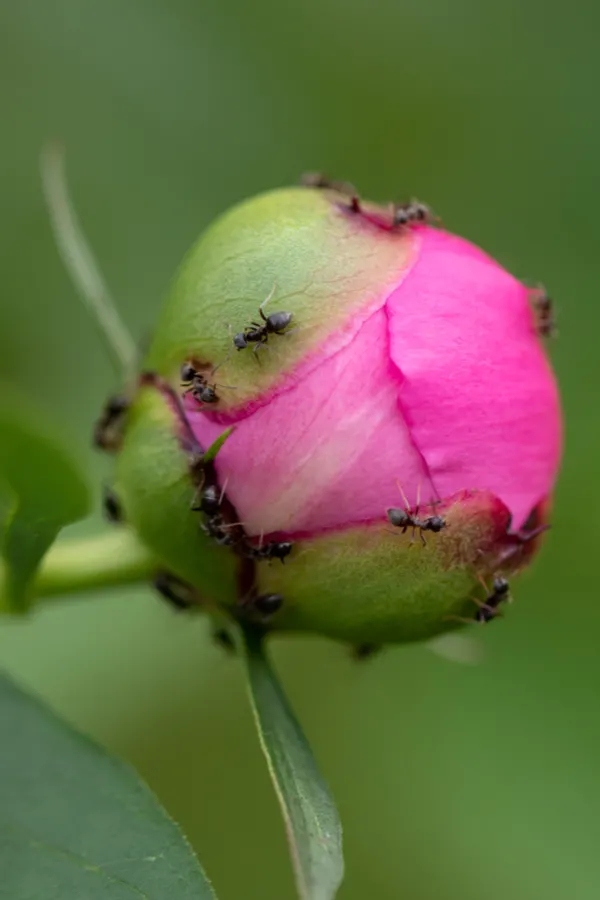
Why So Many Ants?
Don’t be surprised if you see lots of ants crawling around your peony buds. The ants feed off of a peony’s nectar and actually help keep peonies safe from other pests that might actually harm the plant. It’s a perfectly safe, mutualistic relationship.
Deadheading Peony Bushes
Unlike peony trees, peony bushes need to be deadheaded in order to keep new blooms forming. Use clean, sharp pruning shears to cut spent blooms back only to the first full set of leaves down from the bloom, leaving as much foliage as possible.
Fall Peony Care For Bushes
For peony bushes (not trees), the foliage will die off after the first hard freeze. It is best if you remove this dead or decaying foliage. Simply cut the foliage down to just ½ inch above the ground. This will allow the peony bush to concentrate its energy on next season’s blooms.
Fall is also the perfect time to divide and split well-established peony bushes, but dividing isn’t required like it is with some perennials. Doing the splitting and replanting in the Fall allows the roots to have plenty of time to reestablish before going dormant for the Winter.
No Spring Blooms?
There likely won’t be any peony blooms the first couple of years after you plant. In fact, newly transplanted peonies can take up to three years in order for the new growth to produce blooms. But once they are established, you’ll be able to enjoy beautiful, fragrant blooms for many years to come with little effort or maintenance!
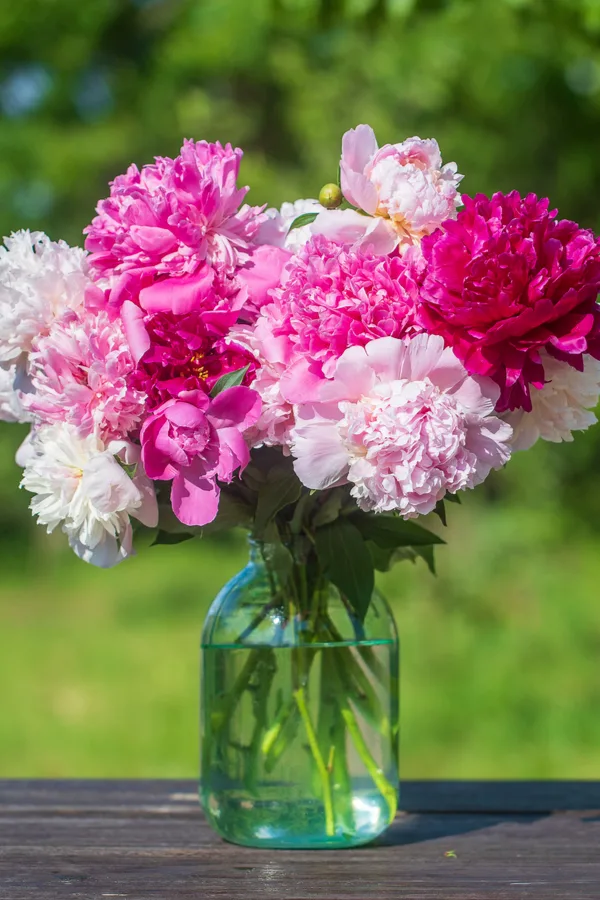
Cut Flowers
Peony blooms make excellent cut flowers. When you cut the blooms properly and keep them in water, they can last more than a week in a vase. Cut blooms early in the morning when the buds are still fairly tight and not opened up yet.
If you are worried about the ants on the peony blooms, just hold the bloom upside down after cutting and gently shake the ants off before you take them indoors. Giving the blooms a quick gentle rinse might be useful as well.
To Conclude…
It’s no wonder why the Peony has been one of gardeners’ favorite perennial plants to grow generations after generations. It’s a great addition for any property where you want lasting beautiful foliage with big, fragrant blooms that will last you for many years to come!
Feel free to download, print out, or save our Peonies At-A-Glance sheet. It is sized for half letter printing but can be scaled if needed.
